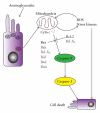Mechanisms of aminoglycoside ototoxicity and targets of hair cell protection
- PMID: 22121370
- PMCID: PMC3202092
- DOI: 10.1155/2011/937861
Mechanisms of aminoglycoside ototoxicity and targets of hair cell protection
Abstract
Aminoglycosides are commonly prescribed antibiotics with deleterious side effects to the inner ear. Due to their popular application as a result of their potent antimicrobial activities, many efforts have been undertaken to prevent aminoglycoside ototoxicity. Over the years, understanding of the antimicrobial as well as ototoxic mechanisms of aminoglycosides has increased. These mechanisms are reviewed in regard to established and potential future targets of hair cell protection.
Figures


References
-
- Schatz A, Bugie E, Waksman SA. Streptomycin, a substance exhibiting antibiotic activity against gram-positive and gram-negative bacteria. Proceedings of the Society for Experimental Biology and Medicine. 1944;55:66–69.
-
- Waksman S. Streptomycin: background, isolation, properties, and utilization. Nobel prize lecture, Nobel Organization, 1952, http://nobelprize.org/nobel_prizes/medicine/laureates/1952/waksman-lectu....
-
- Umezawa H, et al. Production and isolation of a new antibiotic: kanamycin. The Journal of Antibiotics. 1957;10(5):181–188. - PubMed
-
- Waksman SA, Lechevalier HA. Neomycin, a new antibiotic active against streptomycin-resistant bacteria, including tuberculosis organisms. Science. 1949;109(2830):305–307. - PubMed
-
- Weinstein MJ, Luedemann GM, Oden EM, et al. Gentamicin, a new antibiotic complex from Micromonospora. Journal of Medicinal Chemistry. 1963;6(4):463–464. - PubMed
Grants and funding
LinkOut - more resources
Full Text Sources
Other Literature Sources

